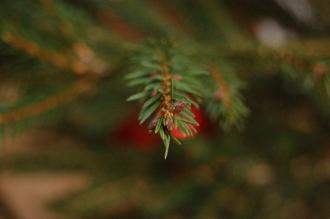
Picea abies (24/12/2011, Vsetin, Czech Republic)
Position: Full sun
Flowering period:
Soil: Moist, well drained, including acidic
Eventual Height: 50m
Eventual Spread: 10m
Hardiness: 3b – 8a
Family: Pinaceae
Picea abies is a fast growing, large evergreen, conical coniferous tree. The dark green leaves are needle like, measuring up to 25mm long and are quadrangular in cross section. The shoots are orange/ brown in colour, and the branches are horizontal. The red/ brown trunk of a mature tree may achieve a diameter of 1.5m. The tree produces wind pollinated monoecious flowers in late spring, the female flowers being pink in color. The green or reddish cones of this tree are up to 17cm long and mature 7 months after pollination. The seeds produced from the cones are black and 0.5cm long.

Picea abies detail (24/12/2011, Vsetin, Czech Republic)
Picea abies, commonly known as the Norway Spruce or Christmas Tree, is native to parts of south east Europe, Norway, Sweden, Finland and Siberia. The cones of P. abies are the longest of any Spruce. There are a number of different subspecies of P. abies including those from Siberia and Switzerland. P. abies is one of the most widely planted species of Spruce and is one of the most economically important coniferous trees in Europe, including for use as a Christmas tree. It is the most climatically tolerant species in the genus. Although it has naturalised in parts of North America it is not considered to be an invasive species. It was named by Linnaeus in 1753.
The etymological root of the binomial name Picea is derived from the Lain Pix meaning ‘pitch or tar’ in reference to the Spruce trees resin. Abies is in reference to the similarity of this tree to the Abies genus.

Picea abies trunk (24/12/2011, Vsetin, Czech Republic)
The landscape architect may find Picea abies useful in reclamation schemes, particularly mine spoil. It may also be planted as a large evergreen specimen tree where space permits.
Ecologically P. abies cone scales are an important source of food for the caterpillar of the Tortrix Moth, the wounded bark is a source of food for the Cydia illutana.
P. abies prefers moist, humus rich fertile, well-drained soils. It will tolerate most pH of soil and prefers acidic soils.
P. abies requires little maintenance.

